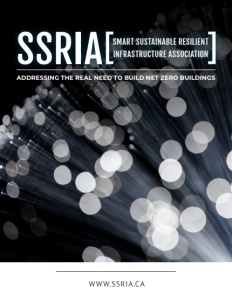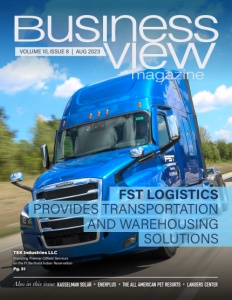Smart Sustainable Resilient Infrastructure Association (SSRIA)
addressing the real need to build net zero buildings
Tackling the challenges in building green properties with the sustainability bottom line in mind
With 40% of global carbon emitted from buildings[1] (including operations and construction of buildings), and the fact that today’s new buildings will still be here in 50 years or more, there is an immediate need to address how the industry designs, constructs and operates buildings. However, the building industry is complex and is slow to adopt change.
Building codes and regulations have pushed for greater energy efficiency in buildings and the systems that operate them but are often recognizing the current market realities versus driving the change necessary to meet climate goals. Currently, the average residential building in Canada uses 95GJ of energy per household[2].
Builders have shown they can bring the annual energy use of a home to zero but this is certainly not being achieved at a meaningful scale and has upfront cost affordability implications that need to be addressed while recognizing the ongoing operational cost savings for a net-zero home. On the commercial side, the energy intensity of buildings is 1.59 GJ per square meter, a reduction of only 0.05 GJ/m2 in the last 20 years[3] and a glaring example of slow adoption.
Smart Sustainable Resilient Infrastructure Association (SSRIA) building industry members (local to Alberta, Canada), were asked to identify the barriers and challenges to building net zero buildings. A stunning 15 barriers were identified demonstrating this is a multi-faceted and complex issue with an average of 4.5 barriers identified by each respondent.
In 2020, the Smart Sustainable Resilient Infrastructure Association (SSRIA) set out to address this challenge and revolutionize the design, construction, and operations of our buildings with the aim to reach a net-zero carbon built environment by 2050. The approach that SSRIA is taking has four key pillars, which are:
– Collaboration – to optimize low carbon solutions while supporting widespread dissemination
– Demonstrations – to validate solutions and reduce perceived risks
– Business growth – to support and optimize the ‘solution makers’ for increased demand
– FutureSkills – to prepare the existing and future workforce to implement the low carbon solutions
Collaboration
Buildings operate as a system but typically each of the professions and various trades complete a building in isolation from one another. This limits the ability to push building performance beyond code requirements and reduces the transfer of knowledge and learnings from projects across the various players involved. Additionally, collaboration is important between building professionals and the ‘solution makers’ to optimize the low carbon solutions being developed.
SSRIA fosters collaboration through networking events, learning webinars, and relationship brokering, but is also a requirement on projects where the owner, designers, builders, suppliers, etc will all work together towards known and agreed upon common goals. The building owner’s commitment is integral to the successful implementation of low carbon solutions in buildings (particularly where regulation and standards lag behind).
Demonstration Projects
Lab testing of technology or new building materials are typically insufficient to appease the risk aversion of the building industry. Demonstrations help validate innovation in an operational setting and most importantly in a local context.
Demonstrations also have the incredible benefit of providing hands-on experience for staff. In one of the demonstration projects that SSRIA supported, which included the use of machine learning to automate the operation of a building ventilation system, the entire local engineering team of the technology supplier was able to have hands-on experience with the system and learn how to work with building maintenance to optimize it.
The demonstrations have also helped to identify further barriers that can now be addressed such as working with and educating permitting officers on new building processes and materials.
Aside from selecting demonstration projects for their potential to reduce carbon in buildings, another key criteria is the ability to replicate the project at a large scale. The end-game is not an endless number of demonstration projects but rather market driven wide scale adoption based on the results of successful demonstration projects.
Business growth
Those who we refer to as the ‘solution makers’, are the entrepreneurs, manufacturers, suppliers etc. who have developed materials or technology that have the potential to reduce energy use and the carbon impact of buildings. These are companies that are either brand new or have been working at a small scale in a niche market for years. In either case, they benefit from customized business services that prepare them for accelerated market demand or to help them overcome barriers such as specific testing and certifications.
Some of the impacts reported after businesses participated in the business growth services included Generating New Business Opportunities (82%), New Business Partnerships (45%), Increased Revenue (27%), and Increased Customers (18%).

FutureSkills
The final component of transitioning the building industry towards net zero carbon is addressing the workforce. As technologies and solutions for net zero buildings evolve, the workforce needs to be ready with the necessary skills to deliver those solutions. In some situations this may look like learning about a new building material that has specific installation requirements or high level building science knowledge to understand the impacts of each professions and trades role on the performance of a building. Widespread dissemination of information gathered from the demonstration project will also support upskilling. This information will range from detailed cost benefit analyses, technical reports, specification sheets, webinars, and visual presentations which can all be accessed through an online database that can be searched by building type or topic area. Some information is already being shared and can be accessed here https://www.ssria.ca/reference-centre.
Through funding support from Alberta Innovates and Prairies Economic Development Canada, SSRIA has been able to support 20 demonstration projects, provide training and educational information to over 900 professionals and students, and assisted with the growth and profiling of 30 small businesses. A few select examples have been shared below but details on all projects can also be found at https://www.ssria.ca/projects-1.
While SSRIA is starting to address a number of the industry barriers to achieve net zero carbon buildings, the building industry can not drive this effort alone. It is imperative for building owners and users to recognize their role in creating demand for higher performing buildings and how they impact the efficiency of buildings through their daily use and maintenance. Working together, all building stakeholders can move us towards net zero.
Demonstration Project Examples
Single Family Residential – Reducing construction materials, time and future energy use with smart technology
A major barrier for the large-scale adoption of this type of technology is home builders risk aversion and price sensitivity. This project is addressing that by collecting data on the installation of their product in over 20 new homes as they are constructed and comparing that to a similar set of homes that are being built (by the same builder) without the wireless technology.
Multi-Family Residential – High-Performance in a Cold Climate
This project has already shared an extensive analysis that was completed to select the wall assembly materials and heating system based on cost and performance parameters. The construction is complete on this project (with a waiting list of tenants ready to move in) and early testing has shown they have exceeded the highest standard for air leakage (Passive House).
This project was designed at a time when timber prices and supply were extremely volatile and therefore were able to apply a locally manufactured non-wood building material.
Commercial/Institutional – Combining Technology for High-Performance Low-Carbon Building Envelopes
This project also completed a detailed cost benefit analysis to determine the best approach to improve the performance of the envelope without exceeding budgetary constraints. The thermal performance of the high-performance assembly selected will be compared against the standard assembly which makes up part of the building
Commercial/Institutional – Managing the impact of EV charging on Buildings
Building owners and operators require solutions to manage the demand for EV chargers at their building sites without needing to make major infrastructure upgrades to meet the added electricity draw.
The charger management software is also being programmed to reduce the GHG emission impact by taking advantage of solar energy production from an existing on-site solar array.
AT A GLANCE
Smart Sustainable Resilient Infrastructure Association (SSIRA)
WHAT: Canadian-based association representing its construction industry-based members, focusing on the barriers challenges and innovations in the green building sector
WHERE: Alberta, Canada
WEBSITE: https://www.ssria.ca/


